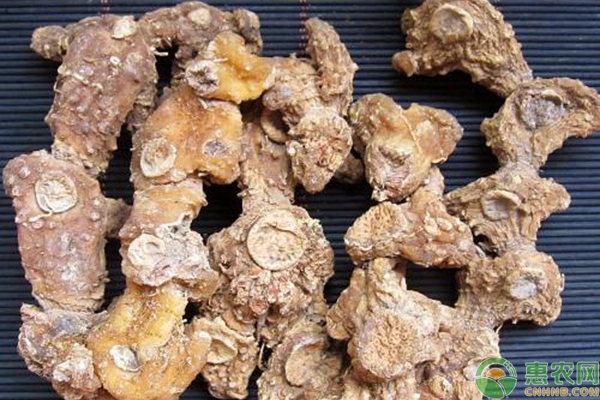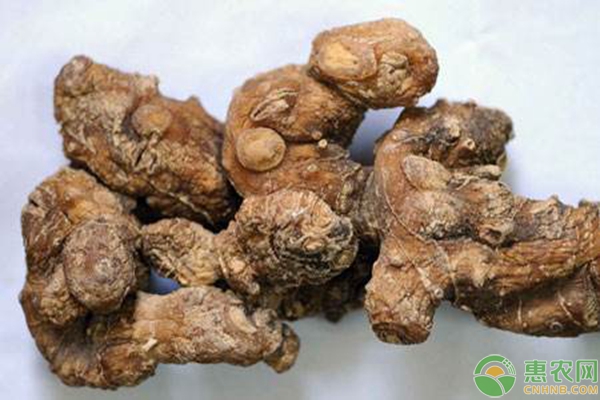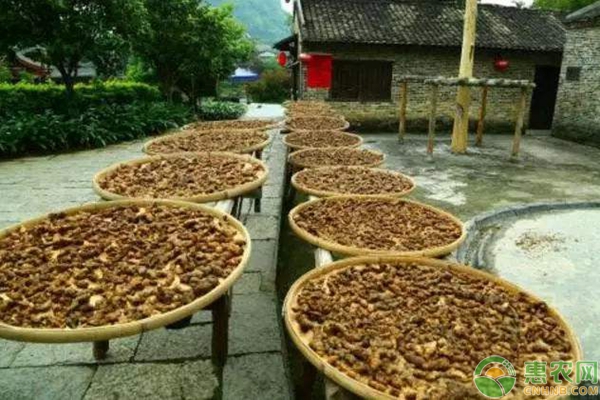Polygonatum is a perennial herb of the genus Liliaceae, which has the functions of tonifying qi, nourishing spleen, moistening the lungs, and benefiting the kidney. Modern medical research believes that Huang Jing has anti-aging, enhance immunity, anti-tumor and lower three high effects. The legend of Jiuhuashan “Golden Land Tibetans, which are eaten by Huang Jing, and turned into a Buddha at the age of ninety-nine,†casts a mysterious color on the medicinal and health care value of Huang Jing. With the in-depth study of Jiuhua Huangjing, the continuous development and utilization of its nutritional value and medicinal efficacy has gradually been accepted by consumers. Therefore, there are “there are long white ginseng in the north and Jiuhua Huangjing in the southâ€. In 2015, Jiuhua Huangjing was recognized as the first batch of forest ecological products by China Forestry Industry Federation; in 2016, Jiuhua Huangjing was named as “National Geographical Indication Protection Product†by the AQSIQ, and Anhui Provincial Administration of Traditional Chinese Medicine determined Jiuhua Huangjing as One of the ten major peony; In 2017, Jiuhua Huangjing won the “Golden Geographical Mark of Agricultural Products†of the Ministry of Agriculture of the People's Republic of China. With people's emphasis on health and the continuous development of Jiuhuashan tourism economy, natural Huangjing resources are far from meeting market demand, implementing large-scale and standardized artificial cultivation of Huangjing, protecting natural Chinese herbal medicine resources, safeguarding people's health and developing tourism. The economy is of great significance. According to the GAP (Good Agriculture Practice) product standard of Chinese herbal medicines, Xiaobian combines the biological characteristics of Jiuhua Huangjing and the practice of pollution-free cultivation techniques in Qingyang County in recent years to sort out the technical regulations for cultivation of Jiuhua Huangjing GAP. 1 Subject content and scope of application According to the GAP product standard of Chinese herbal medicines, this regulation stipulates the technical requirements for the standardized cultivation of Jiuhua Huangjing. This procedure is applicable to the production area specified by Jiuhua Huangjing “National Geographical Indications Protection Products†in Qingyang County, Anhui Province. The Jiuhua Huangjing described in the regulation is a Chinese herbal medicine in the Jiuhuashan area, which is a multi-flowered yellow essence. According to the regulation, under normal conditions, 4 to 5 years old Rhizoma can produce 52 500 ~ 67 500 kg / hm2 rhizomes or 7 500 ~ 10 500 kg / hm2 of dried yellow essence. 2 Reference standard GB 3095—2012 Ambient air quality standard; GB3838—2002 Surface water environmental quality standard; GB4285—1989 Pesticide safety use standard; NY/T1276—2007 Pesticide safety use general rules; GB5084-2005 Farmland irrigation water quality standard; GB16518—1995 Soil environment Quality Standards (Secondary Standards); "Quality Management Regulations for Chinese Herbal Medicine Production (GAP)"; "Guidelines for the Rational Use of Fertilizers" (General Rules); Pharmacopoeia of the People's Republic of China (2015 Edition); Import and Export of Medicinal Plants and Preparations Green Industry Standards, Ministry of Foreign Trade and Economic Cooperation. 3 Production conditions 3.1 Natural conditions of origin 3.1.1 Geographic location. Qingyang County is located in the northern part of the mountainous area of ​​the south of the Yangtze River. It is close to the south bank of the Yangtze River. The mountains and rivers are beautiful and the humanities are gathered. Jiuhua Mountain, one of the four major Buddhist holy places in the country, is located in the territory. The "G318" National Road, the G3 Expressway and the Tongjiu Railway Station , "S103" provincial road straight through the north and south. It borders Nanling and Qixian in the east, Huangshan and Shitai in the south, and Guichi in the west, and Tongling in the north. The total area of ​​the county is 1 180 km2, the length of the north and south is about 65 km, and the width of the east and the west is about 40 km, accounting for about 0. 87%. 3.1.2 Climatic conditions. Qingyang County has a subtropical monsoon humid climate with mild climate, humid air, abundant rainfall, four distinct seasons and abundant sunshine. The annual average temperature is about 16 °C, the frost-free period is 230 days, the average precipitation is 1 650 mm, and the sunshine hours are 2 100 h. There is no heat in summer and no cold in winter. It is suitable for the natural growth of medicinal plants such as Huangjing, Peony, Eucommia and Platycodon grandiflorum. 3.1.3 Soil conditions. The soil parent material in Qingyang County is mainly composed of limestone, granite and argillaceous rock. The soil is dominated by sandy loam and supplemented by clay. The cultivated layer is deep and loose, rich in organic matter, suitable for a variety of plant growth. According to the results of soil census analysis from 2007 to 2014, the soil organic matter in the county is 21. 99 to 49. 22 g / kg, total nitrogen is 1. 36 ~ 2. 68 g / kg, effective phosphorus is 7. 32 to 17. 11 mg / kg, available potassium is 55. 39 ~ 114. 91 mg / kg, slow-acting potassium is 180. 20 to 489. 75 mg / kg, pH 6. 5 ~ 7. 2. Among them, the status of soil nutrients in dryland is pH 5. 8, organic matter 21. 7 g / kg, total nitrogen 1. 37 g / kg, alkaline nitrogen 138 mg / kg, available phosphorus 18. 7 mg / kg, available potassium is 114. 2 mg / kg, slow-acting potassium 455. 2 mg / kg, the trace elements of copper, manganese, iron and zinc are respectively 1. 61, 15. 62, 29. 54, 3. 94 mg / kg, effective sulfur is 24. 37 mg / kg, effective boron is 0. 35 mg / kg. According to a special survey, the proportion of soil selenium in the domain is 27%. Tea, Chinese herbal medicine and other crops are rich in selenium, which is one of the excellent areas for producing selenium-enriched agricultural products. 3.2 Species and cultivar types Polygonatum is a perennial herb of Liliaceae and Polygonatum, and Jiuhua Huangjing of Qingyang County is a multi-flowered yellow sperm with the scientific name Polygonatum cyrtonemaHua. The cultivated species are Qingyang local fine species that are native to Jiuhuashan area and have leaf-shaped ovate shape. 3.3 The biological characteristics of Polygonatum multiflorum perennial herb, roots and stems traverse, hypertrophy, nodular or globular, leaves alternate, leaf back gray green, ventral green, parallel veins 3 ~ 5, uplift 2. 5 mm, lobes 6, triangular-ovate, ca. 3 mm; stamens 6-locate, inserted into middle part of calyx, filaments ca. 3–4 mm, apex with papillae or satelikely sateately 12 to 15 mm long, berry spherical purple black. Flowering period from April to June, fruiting period from June to October. The seeds of Rhizoma Polygonati are in the shape of a bead, the seeds are hard, the umbilicus is obvious, and it is dark brown. The 1000-grain weight is about 33 g. The germination rate of seeds stored dry at room temperature is low. Low temperature sand storage and variable temperature sand storage are conducive to the development of embryos, breaking seed dormancy, shortening germination time, and improving germination rate and uniformity. The seed is suitable for germination temperature of 25 ~ 27 °C. Huang Jing has the characteristics of warmth, phobia, glare, fear of drought and fear of sputum. It is suitable for cultivation in low mountains and low mountains and sparse forests. 4 Jiuhua Huangjing GAP cultivation technology 4.1 Land selection and site preparation 4.1.1 Site selection. Polygonatum can be grown in most areas of Qingyang County. It is most suitable for planting in the wet and fertile forest land or mountain, forest edge, grass or under-forest open area, and planting under sparse forest. Soil fertile and loose humus-rich sandy loam is best cultivated; sticky, heavy or barren, arid soils and heavy metals such as lead, mercury, chromium, arsenic, and soils with excessive levels of toxic and hazardous substances are not suitable for cultivation. 4.1.2 Land preparation. It is required to deepen the soil by more than 30 cm, and the paddy soil cultivation requires a deep turn of more than 50 cm to break the bottom of the plow. Sloping land should be built on the contour line to prevent soil erosion. Generally, the width of the face is 1. 2 m, the length of the raft is 10 to 15 m, and the raft surface is 10 to 15 cm above the ground level. In the sputum, the base fertilizer is applied, and the high-quality rotted farmyard manure is 60 000 kg / hm2, which is evenly applied into the soil of the boring machine, and then deeply turned 30 cm, so that the fertilizer and soil are thoroughly mixed, and then finely squashed and leveled for sputum. Jiuhua Huangjing's GAP cultivation technical regulations 4.2 Yellow sperm reproduction 4.2. 1 Seed propagation. Choose 3 to 4 year old plants that grow robust and free from pests and diseases, and strengthen the field management to prevent and control pests and diseases. When the autumn berries are picked from green to yellow, they are put into the sieve and washed in the river water, dried in the room, and treated with low temperature sand. The method is: Dig a deep pit (40 cm deep and 30 cm wide) in the courtyard to the leeward wind, mix 1 seed and 3 clean fine river sands evenly, and the humidity of the sand is held in groups by hand. That is, the amount of water is not dripping between the fingers, put the mixed wet sand into the pit; put the corn or soybean straw in the center to facilitate ventilation; then cover it with fine sand to keep the pit moist, check frequently to prevent falling and rat When the buds begin to germinate in the spring of the next year, the seeds are removed and sieved to wet sand for sowing or direct sowing. Can be broadcast or broadcast. Striping: In the whole good seedbed, the distance between the rows of 15 cm and the ditch is 3 to 5 cm deep, and the germinated seeds are evenly spread into the ditch. Covering soil thickness 2. 5 ~ 3. 0 cm, slightly pressurized, keep the soil moist [Jishan Huayao]. The yellow embryo has a secondary dormancy phenomenon. Under natural conditions, the seedling rate in the same year after sowing is less than 10%, and it can reach 80% to 90% in the next year. In the year of planting in the nursery, we must pay attention to the drainage and weeding work of clearing ditch. After the emergence of spring in the next spring, we must pay attention to strengthening management and building a shade shelter. Timely weeding, preventing grass shortage, pouring and applying thin manure water, and promoting the growth of seedlings. In the end of August, the shade shelter can be removed. It usually takes 4 to 5 years to grow large-sized commercial seedlings. 4.2.2 Rhizome reproduction. Plants that are robust and have the same traits and no pests and diseases are selected as seedlings. In the early spring, the rhizomes with buds were directly intercepted as seedlings (5 to 7 cm long, 2 to 3 knots). The seedlings were soaked with 50% carbendazim 500 times or the wounds were treated with grass ash, and then planted after drying. 4.3 Planting spring planting is carried out in late March-early April, and autumn planting is carried out in September-October. At the time of planting, on the side of the sulcus, the planting distance is 27 cm × 27 cm and the depth is 13 to 17 cm. One hole is planted at each hole, and the buds are arranged on the side of the shaded plants. After planting, apply thin manure and manure water, cover the fine soil and flush with the noodles. 4.4 Field Management 4.4.1 Interplanting. Huang Jing is a hi-yin plant, and proper interplanting of high-stalk crops not only benefits the growth of yellow essence, but also increases economic benefits. It is best planted under the forest, and can also be intercropped with fruit trees such as peach, plum, apricot and chestnut. 4. 4. 2 cultivating, weeding, topdressing, and covering grass. Every year, in April, June and November, weeding and weeding once, combined with cultivating for topdressing. The cultivating should be shallow so as not to hurt the roots. After topdressing in April and June, the top dressing is followed by manure and manure and a small amount of chemical fertilizer such as urea. After weeding in November, 750 kg /hm2 of superphosphate and 750 kg /hm2 of rapeseed cake were applied. It is recommended to use biological bacterial fertilizer (organic fertilizer), biogas slag fertilizer, liquid fertilizer; edible fungus stick waste, rapeseed cake fertilizer and other organic fertilizers, chlorine-free three-element compound fertilizer, potassium dihydrogen phosphate. In the mountainous areas, soil organic matter can be increased by cutting green and embedding green. Industrial waste fertilizer and municipal waste fertilizer are prohibited. Summer grassing not only inhibits weed growth, avoids soil erosion, maintains soil moisture and nutrients, improves soil environment, but also improves the yield and quality of yellow essence. The pulverized rice, wheat straw, rapeseed shell, and the like can be used as a covering. 4.4.3 Drainage. Huang Jingxi is wet and afraid of drought, and the field should be kept in a humid state frequently; in July-August, high temperature and dry weather should be watered in time, and drip irrigation or sprinkler irrigation can be used if conditions permit. In the rainy season, it is especially important to pay attention to clearing the ditch to prevent the roots from being damaged. 4.5 Pests and diseases 4. 5. 1 Main pests and diseases. The disease includes leaf spot, chalk disease, black spot, anthracnose, soft rot, blight, etc. Among them, leaf spot is the most common, and white mites are the most serious damage; the main pests are cockroaches and small tigers. Golden worm, leaf mites and a food bud mosquito. 4.5.2 Green prevention and control technology. 4.5.2.1 Select disease-free seedlings. Plant quarantine must be carried out in the field; seed treatment should be carried out before planting. It was immersed in 50% carbendazim 500 times solution for 30 min, dried and then planted. 4.5.2.2 Agricultural measures. According to the growth and development characteristics of Polygonatum, it is necessary to create an environment conducive to its healthy growth. Focus on shading (cultivation or shading under the forest), anti-staining, drought prevention and other aspects. 4. 5.2.3 Physical and chemical traps. The use of frequency-vibration insect-extinguishing lamps and black light lamps can effectively trap the chafers (the cockroach) and the cockroaches and leafhoppers. According to different terrain, each 1. 3 ~ 2. 7 hm2 Install a frequency pulsating insect killer. Sweet and sour liquid traps tigers: 1 part of sucrose, 4 parts of vinegar, 1 part of wine, 16 parts of water, plus 90% of the original drug of trichlorfon. 1 serving, with sweet and sour temper, can effectively trap the tiger. Place a pot [Jishan Huayao] every 90 ~ 150 m2. 4.5.2.4 Chemical control. The use of under-forest or imitation wild cultivation of yellow sperm pests and diseases is relatively light, and generally does not require chemical control. However, in the case of continuous cropping or mismanagement of dry land, chalk disease, mites, leaf blight, etc. may occur more seriously, and it is necessary to carry out key prevention and control. (1) Chalk disease. Rotation or water-and-dry rotation; disinfection with soil disinfectant before planting; use 5% Jinggangmycin or 23% thiabendamide suspension 800 to 1 000 times before the onset or early onset, root treatment, each plant Irrigation 4 to 0. 5 L. Fill it again after 7 to 10 days. (2) 蛴螬. For the more serious plots, use 40% chlorpyrifos or 90% trichlorfon 1000 times to control the water. The pest control drugs should be carried out in strict accordance with the green food production standards; the use of highly toxic and highly residual pesticides is strictly prohibited. 4.6 Harvesting and processing of Huangjing can be harvested in 2 years after planting, but the yield is the highest in 4 to 5 years after planting, and the yield can increase by 30% to 50% in 1 year. It is better to use the excavation when the leaves are yellow and dry in the autumn from October to November. Use a double-toothed pick. According to the direction of ridge planting, the rhizome of Rhizoma Polygonati is excavated in turn, and the remaining part of the ground is removed. The soil is scraped off with a bamboo knife or a wooden strip. Be careful not to damage the rhizome. The roots need not be removed. If there is a wound, it should be treated separately. Do not wash with water before processing. When the initial processing, it can be washed with water, steamed in the steamer for 3 to 4 hours, steamed to the heart, and then taken out and softened to dry. Huang Jing product specifications: sweet and not bitter, no white heart, no roots, no mildew, no insects, no pesticide residues exceeding the standard, qualified, large, fat, yellow, cross-transparent, yellow polysaccharide content More than 10% is the best. The above is the GAP cultivation technical regulation of Jiuhua Huangjing compiled by Huinong. Xiaoji Huangjing is currently mature in artificial cultivation techniques, but seedling reproduction is still a bottleneck for large-scale planting. The breeding methods of Polygonatum are seed propagation and asexual reproduction (rhizopter, tissue culture), but the production is mainly based on the rhizome with bud head as the propagation material. Although seedlings have a large reproductive coefficient, it takes 4 to 5 years from sowing to seedling, which is long and costly. Although artificial tissue culture has been successfully reported, it is far from the technical level of Chinese herbal medicines such as white peony and sarcophagus. Tetanus Shot,Tetanus Vaccine,Hepatitis B Injection,Hep B Vaccine FOSHAN PHARMA CO., LTD. , https://www.forepharm.com

